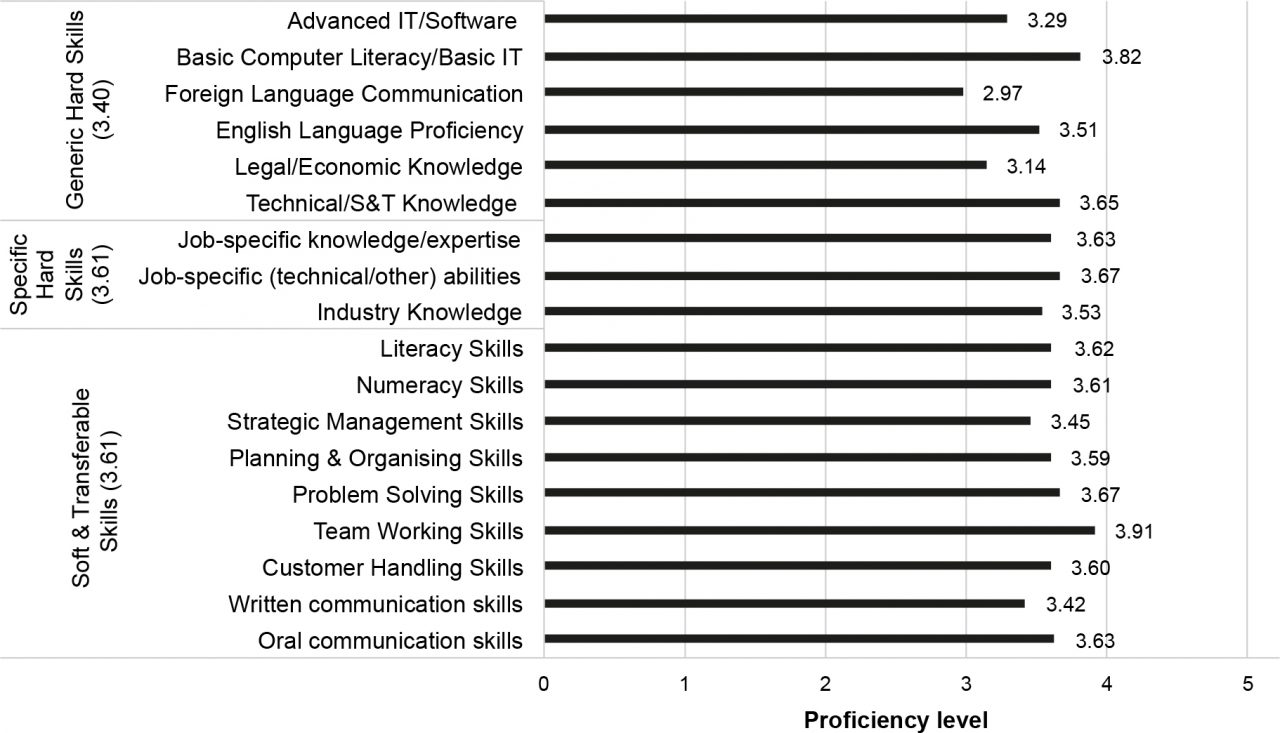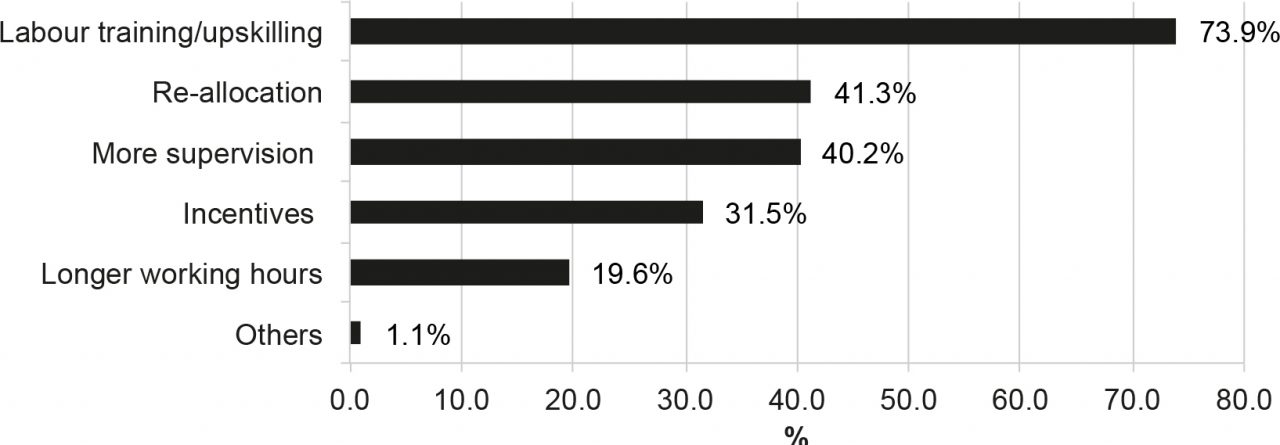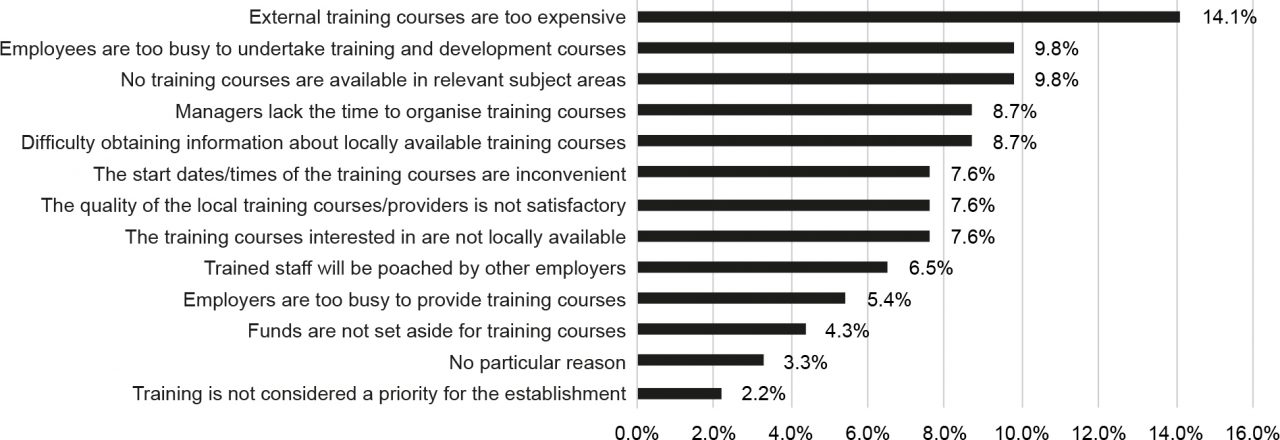Executive Summary
- A strategic skills monitoring system is very much needed that can provide Penang with dynamic human capital growth and sustain it for a high-achieving economy
- A recent employer survey shows that current employees are indeed increasingly proficient in specific hard and soft skills, and this is likely due, at least partially, to the skills development efforts that have been undertaken by employers so far
- However, the skills development infrastructure, though substantial, is diverse, and detailed information about its parts is fragmented and not easily available
- Better coordination and interaction between public and private institutions, as well as state and federal government agencies on skills development projects are badly needed
- Hiring difficulty is more prevalent for positions with very high skill-specificity requirements, and it is a challenge for universities and colleges to tailor skills specifically needed by industry
Introduction
Multifaceted concerns have been raised in recent times regarding graduate employability and the quality of education in Malaysia. These stem from ample evidence of a misalignment of skills and competences produced by institutes of higher learning with those required by industry.
This is not a new problem and measures have in fact been taken by various employers to upskill employees.
More than 200,000 new graduates enter the workforce annually, and skills development is imperative for economic growth and social development in the country. Based on the Ministry of Higher Education (MOHE)’s annual Graduate Tracer Study, only half of the graduates had employment secured during their convocation ceremony, and from 2008 to 2015, at least a quarter of the graduates have remained unemployed. Half of them are from the Arts and Social Sciences.
According to the Malaysian Investment Development Authority (MIDA), manufacturing investment projects approved nationwide generate at least 170,000 new jobs every year. Theoretically, these jobs should be taken by new graduates – especially where less experienced employees are required. Whatever the case, Malaysia today does suffer from a shortage in skilled workers, be these of the experienced variety or not.
This has led many to question the quality of education in the country. The National Graduate Employability Blueprint 2012-2017 identified poor command of English as a major area of concern. However, we observe that while the ability to speak English is most clearly lacking among local graduates, an even more worrying concern involves poor strategic communication ability. The latter requires a coherent and continued skills learning environment as a remedial measure.
In Penang, the upskilling infrastructure is sizeable, and often spearheaded by private training providers offering a small number of public-private partnership courses that address skills issues among highly qualified workers.
This article sheds light on the efficacy of Penang’s skills development infrastructure today, and how public policy support for human capital growth can be best provided.
The skills development infrastructure today
We identify three levels of skills development infrastructure available in the education and training establishments. These involve both conventional and unconventional skills learning (Table 1).
Primary skills development is a traditional approach and occurs through formal education. Public and private schools, universities and colleges play a major part in this, and the skills and competences developed are usually generic and transferable. These are classified as generic hard and soft skills.
Table 1: Penang skills learning infrastructure

Secondary skills development involves upskilling employees through private training companies, human resource consultants and public-private partnership skills development initiatives, and is strongly responsive to the needs of industry. This level more directly reflects the skill deficiencies present in the workforce, and testifies to the inadequacies in traditional education where the attainment of desired skills is concerned.
There exists therefore a number of companies offering talent development programmes, such as flexiEdge Training PLT, JobStreet Academy, Dream Catcher Consulting Sdn Bhd and Xtrategize Technologies Sdn Bhd. They provide courses on subjects ranging from basic IT to specific technical skills and professional soft skills.
With regard to public-private skills development initiatives, the Penang Skills Development Centre (PSDC) runs technical and talent development courses together with industry participations, which cater to engineers, technicians, students and even lecturers. System integrator, cybersecurity, statistical data modelling and augmented reality system development are a few of the courses available to the workforce. The FMM Institute, on the other hand, provides training for a lower segment of the highly qualified workforce.
The tertiary infrastructure encompasses public institutionalised skills augmentation initiatives. The Northern Corridor Implementation Authority (NCIA) and TalentCorp, for example, collaborate with USAINS Group to provide upskilling programmes and short courses for engineers while addressing skill shortages and deficiencies among graduates. The tertiary infrastructure often makes use of the secondary skills development infrastructure in its programmes.
At the Penang state level, some STEM learning organisations have been established in cooperation with private consultants and MNCs over the past five years.[2] These include Tech Dome Penang, @CAT, Penang Science Cluster, Penang Math Platform (PMP) and the Penang Digital Library. Combined with PSDC, Penang STEM is formed to provide synergy to skills enhancement programmes, workshops and exhibitions, and to collaboratively discuss state-of-the-art technological development among STEM learning organisations. On top of the conventional skills development system, these initiatives are considered as education breakthroughs where the extra-curriculum STEM education starts from a very young age.
The level of skill deficiencies among employees
Though Penang may be small in size and its economy employs only 5.8% of the national workforce, the available skills development ecosystem is significant and diverse. Partly in response to the challenge of being small, empowering its workforce with required skills, knowledge and qualifications is the key focus for many of the employers and stakeholders in the state.
A survey has shown, contrary to expectations, that employees in Penang are in fact seen by their bosses to be more proficient in specific hard and soft skills than in generic hard skills. At the same time, some employers and recruitment companies are concerned about excessive emphasis on theoretical knowledge overshadowing approaches that favour critical thinking and that direct students towards the solving of real world problems.
A total of 92 companies, coming from core manufacturing and services industries in Penang, participated in this employer survey. With skill types ranked from very low (1) to high (5) proficiency, specific hard skills, and soft and transferable skills score an average rating of 3.61 while the average score for generic hard skills is slightly lower at 3.4 (Figure 1).
The satisfactory ratings for specific hard and soft skills are attributed to the continued skills development measures taken over time by employers that are job- and industry- specific. In the secondary infrastructure, private companies and public-private initiated programmes are key in enhancing the skill level. As depicted in Figure 2, about three-quarters of employers use training to upskill skilled deficient employees.
In addition, our study also found that establishments originated from Germany, Japan, Singapore and the US are more inclined to offer skills training to their employees than local establishments.
Figure 1: Firm rating of the skill proficiency level of employees by specific skills

Source: Employer survey (Penang Institute, 2017).
Figure 2: Measures taken to address skill deficiencies

In terms of core job functions, accounts and finance have the highest share of current employees that are fully skilled among the highly qualified employees. They are followed by programmers and software developers where more specific and cutting-edge technical skills are required, including skills in programming languages (JavaScript, Python, C++, mobile app, etc.) and web design (user interface and user experience).
Nevertheless, it should be noted that universities and colleges focus necessarily on generic skills. Tailoring skills specifically to the needs of an individual industry can be rather challenging at that level. Hiring difficulty is more prevalent for positions with high skill-specificity requirements. For example, IC designers require knowledge in SPICE simulators, Spectre and Analog Artist. These are definitely job- and firm-specific requirements.
Skills development is not solely used to mitigate skill deficiencies in the workforce. Employers also need to provide skills training to existing employees and new hires when the required skills are not available in the market. This is what is called skill shortage. To overcome this, some employers opt to hire under-skilled workers instead, and then train them in acquiring the required knowledge and competences.
Issues and challenges to skills development
When the company is small or when the deficiency in skilled workers is small, it is seldom that skills training programmes are provided for employees. SMEs tend not to have sufficient resources and are prevented by budget constraints to take such measures. The following are the main reasons why skills training may not be available to employees: (1) external training courses are considered too expensive; (2) employees are too busy to attend training courses; (3) the non-availability of training courses in the relevant skill easily available in the relevant skill; (4) difficulty in getting information about the available courses; and (5) managers are too busy to organise training for the staff (Figure 3).
Figure 3: Reasons preventing organisations from providing skills training opportunities

Reasons (1), (2) and (5) are strongly associated with the operating behaviour of individual firms. Some employers have restricted time and budget for organising training and development courses, or their manpower is too limited for them to allow employees to go for capacity-building courses. Consequently, these employers may see employees leaving to take up positions in other firms that offer upskilling opportunities.
Reasons (3) and (4), on the other hand, are institutional issues that require the full attention of public policy makers. The lack of information about the skills training programmes that are available in the state or in the country hinder public planning from being effective. The situation is worsened by the political tension that has existed between the state and the federal government since 2008. The difficulty in aligning skills development initiatives initiated by the state government and by the federal government undermines most ambitions of creating a cohesive skills development ecosystem.
Even though public and private institutions undertake a variety of skills training programmes, most of them develop their own policies, and do not rely on collaborative synergy.
Therefore, there is a great need for an institutional framework to address information flows about the skills development infrastructure, and that can collate employers’ concerns about human resources. This cannot but enhance public involvement and put pressure on the state to make effective use of the resources available in the region.
It should also be noted that no employer considers skills training to be to their advantage. Employees with newly acquired skills tend to be more sought after by other firms. They can demand higher salaries and conditions, and are more likely to get them with a new employer than with the current one. This disincentivises some from thinking in the direction of long-term investment in in-house training for their staff.
Proposal for a collective skills strategy
The skills development landscape is complex, substantial and varied, with the primary focus being on highly qualified labour, and industry-specific as well as soft skills. The demand for skills training remains high, and private training institutions therefore appear to take the initiative and to broaden the scope of training courses.
On the whole, the government has the potential to invest in and encourage innovative teaching methods. This has to start at school level. For example, something like Python should be introduced in the upper-high school curriculum to be in tandem with current skills requirements.
While the existence of different layers of government has to be recognised, a number of strategies for developing an effective upskilling strategy are suggested in the Penang Skilled Workforce Study completed in 2017. For instance, educational institutions should focus on improving the skill readiness of graduates in most demanded hard and soft skills, and increase the flexibility and lessen the response time to accrediting and adopting new curricula.
To elevate the practice-orientation of education, internship opportunities should become an integral part of curricula to expose students to “real world” experiences. Industry-university partnerships are necessary for devising curricula that are in tandem with industry needs. Likewise, the role of university career centres should be highlighted in company engagement activities, and this should include providing information on job openings, career advice and job interview skills.
As part of the organisational framework, we further propose that information pertaining to skills development programmes should be improved, and can be improved, through better coordination between relevant parties. This can be achieved by: (1) setting up a state employment and skills unit; (2) enhancing the role of the Career Assistance and Talent (CAT) Centre; (3) improving the skills information system, including data about the new types of skills being demanded; (4) setting up an active skills monitoring committee; and (5) improving skills policy coordination between the state and federal governments.
Concluding remarks
Skill mismatches, deficiencies and shortages have often been seen as a blame game. While educational institutions play key roles in nurturing skills and learning, harnessing employee skills should be recognised as part of company skills development strategies. Businesses need to be aware that training their employees are necessary for their own survival.
Furthermore, skills development is a global challenge, and the mismatch of skills is also a big problem in countries like the UK (Belgutay, 2017), Australia, India (among its ICT-related workforce) (Mohd Adam et al., 2012), and Spain (Teijeiro et al., 2013), just to name a few. As technology progresses, education curricula have to respond immediately, and that is best done through constant collaboration with industry players.
In summary, an effective skills strategy is necessary to create an ecosystem that brings together stakeholders and policy makers in realising a strategic skills monitoring system that can provide Penang with dynamic human capital growth and a high-achieving economy.
References
Belgutay, J. (2017, May 4). UK adults skills not aligned with industry, warns OECD. Retrieved from https://www.tes.com/news/further-education/breaking-news/uk-adult-skills-not-aligned-indus try-warns-oecd
Ministry of Higher Education (MOHE, 2012). The National Graduate Employability Blueprint 2012-2017.
Mohd Adam, S., Muhammad, R. H., Husnayati, H. and Asadullah, S. (2016). Information and communication technology workforce employability in Malaysia. Campus Wide Information Systems. 29 (2), pp. 80-89
Penang Institute (2017). Penang Skilled Workforce Study.
Teijeiro, M., Rungo, P. and Freire, M. J. (2013). Graduate competencies and employability: The impact of matching firms’ needs and personal attainments. Economics of Education Review. 34, pp. 286-295
[1] Parts of this paper are based on a broader project entitled Penang Skilled Workforce Study run by Ms Ong Wooi Leng of Penang Institute and for which Dr Leo van Grunsven of Utrecht University was Research Advisor. The full report is available at https://goo.gl/9Rqxos
[2] STEM stands for Science-Technology-Engineering-Mathematics.
Managing Editor: Ooi Kee Beng Editorial Team: Regina Hoo, Lim Su Lin, Nur Fitriah, Ong Wooi Leng
You might also like:
![Heritage Tourism in George Town: A Complicated and Always Controversial Issue]()
Heritage Tourism in George Town: A Complicated and Always Controversial Issue
![Investment Facilitation: A One-Stop Mechanism Needed to Assist Investors in Penang and Malaysia]()
Investment Facilitation: A One-Stop Mechanism Needed to Assist Investors in Penang and Malaysia
![Challenges and Opportunities for Penang’s Labour Market amid the Covid-19 Pandemic]()
Challenges and Opportunities for Penang’s Labour Market amid the Covid-19 Pandemic
![Social Media Usage among Penangites: A Tool of Benefit or Distraction?]()
Social Media Usage among Penangites: A Tool of Benefit or Distraction?
![Mandatory Public Whipping May Become a National Trend]()
Mandatory Public Whipping May Become a National Trend






